BSBINN601: Assessment on Leading and Managing Organisational Change
VerifiedAdded on 2020/04/21
|59
|11276
|152
Homework Assignment
AI Summary
This document presents a comprehensive student assessment pack for the BSBINN601 unit, focusing on leading and managing organisational change. It includes learning checkpoints, formative assessments, and a final summative assessment. The assessment tasks are divided into two parts: Part A consists of a series of questions designed to evaluate the student's understanding of change requirements, organisational development interventions, and strategic planning. Part B involves a project that requires the student to contribute to organisational development at BizOps Enterprises, applying the concepts learned throughout the unit. The assessment covers topics such as identifying change needs, implementing organisational development activities, maintaining development programs, and understanding the impact of change on structure, processes, technology, and people. The assessment emphasizes real-world application, requiring students to analyze an organisation's objectives, strategies, and responses to external factors. The document concludes with student declarations, assessment instructions, and information on plagiarism and academic integrity.
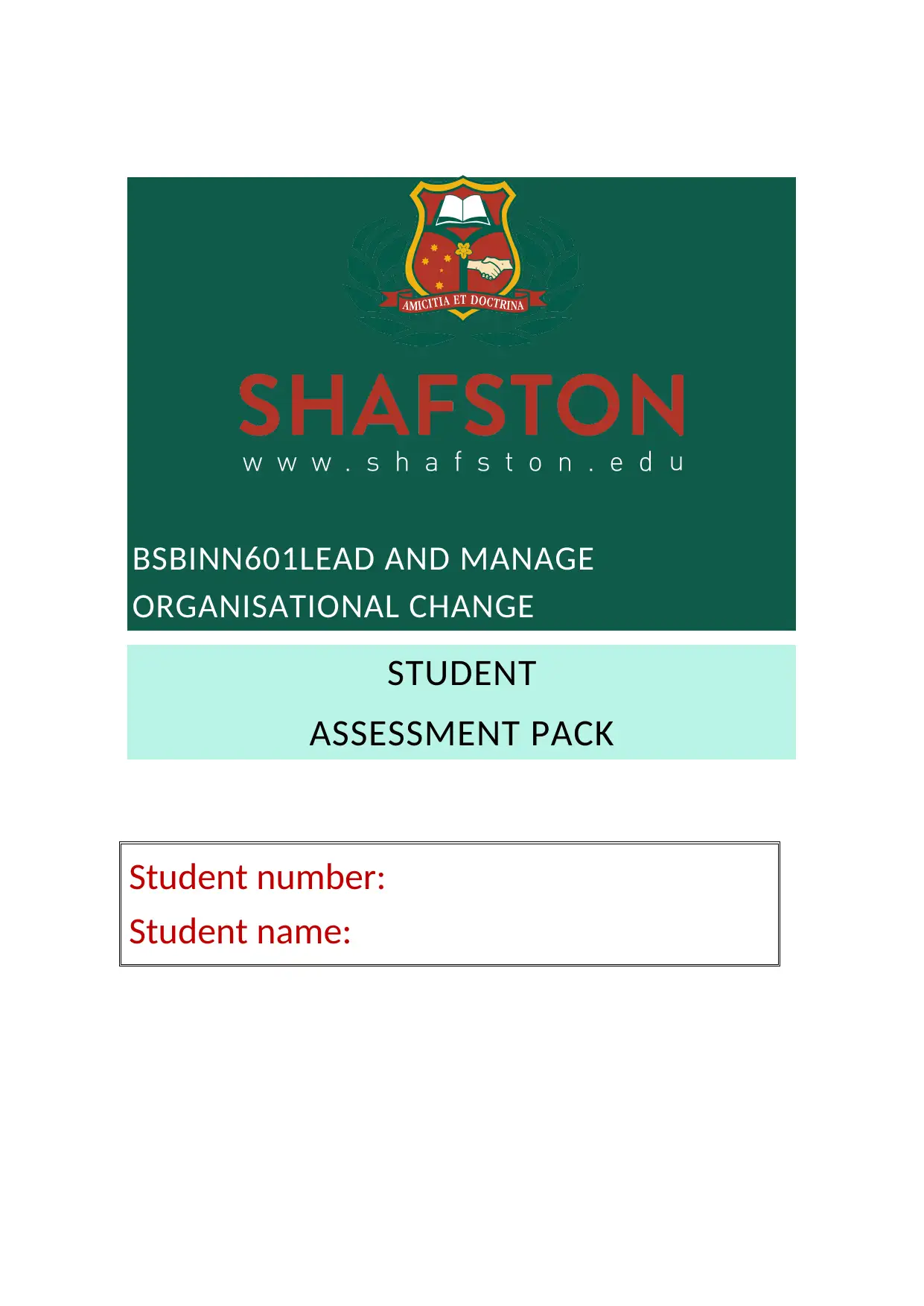
BSBINN601LEAD AND MANAGE
ORGANISATIONAL CHANGE
STUDENT
ASSESSMENT PACK
Student number:
Student name:
ORGANISATIONAL CHANGE
STUDENT
ASSESSMENT PACK
Student number:
Student name:
Paraphrase This Document
Need a fresh take? Get an instant paraphrase of this document with our AI Paraphraser

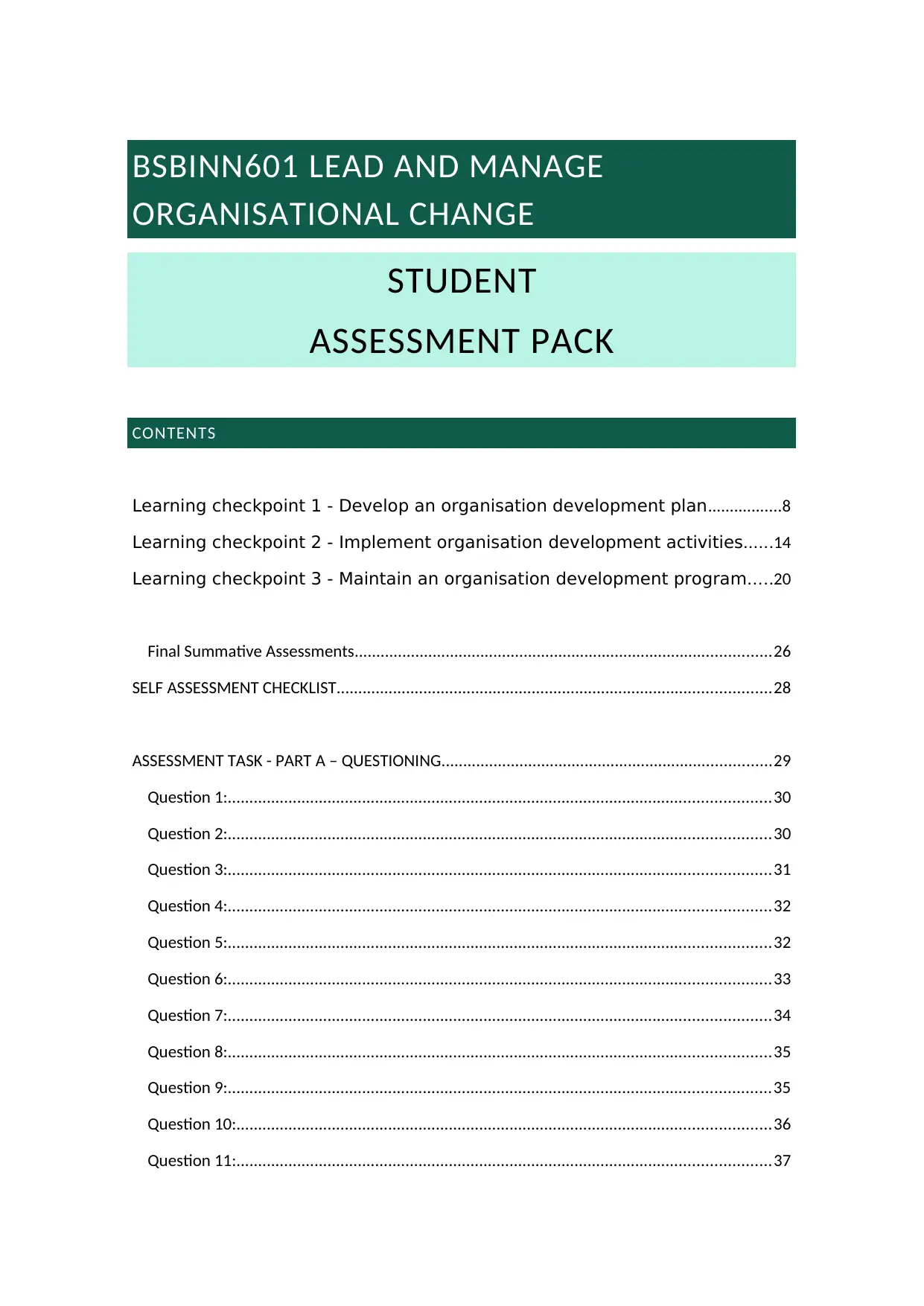
BSBINN601 LEAD AND MANAGE
ORGANISATIONAL CHANGE
STUDENT
ASSESSMENT PACK
CONTENTS
Learning checkpoint 1 - Develop an organisation development plan.................8
Learning checkpoint 2 - Implement organisation development activities......14
Learning checkpoint 3 - Maintain an organisation development program.....20
Final Summative Assessments................................................................................................26
SELF ASSESSMENT CHECKLIST....................................................................................................28
ASSESSMENT TASK - PART A – QUESTIONING............................................................................29
Question 1:.............................................................................................................................30
Question 2:.............................................................................................................................30
Question 3:.............................................................................................................................31
Question 4:.............................................................................................................................32
Question 5:.............................................................................................................................32
Question 6:.............................................................................................................................33
Question 7:.............................................................................................................................34
Question 8:.............................................................................................................................35
Question 9:.............................................................................................................................35
Question 10:...........................................................................................................................36
Question 11:...........................................................................................................................37
ORGANISATIONAL CHANGE
STUDENT
ASSESSMENT PACK
CONTENTS
Learning checkpoint 1 - Develop an organisation development plan.................8
Learning checkpoint 2 - Implement organisation development activities......14
Learning checkpoint 3 - Maintain an organisation development program.....20
Final Summative Assessments................................................................................................26
SELF ASSESSMENT CHECKLIST....................................................................................................28
ASSESSMENT TASK - PART A – QUESTIONING............................................................................29
Question 1:.............................................................................................................................30
Question 2:.............................................................................................................................30
Question 3:.............................................................................................................................31
Question 4:.............................................................................................................................32
Question 5:.............................................................................................................................32
Question 6:.............................................................................................................................33
Question 7:.............................................................................................................................34
Question 8:.............................................................................................................................35
Question 9:.............................................................................................................................35
Question 10:...........................................................................................................................36
Question 11:...........................................................................................................................37
⊘ This is a preview!⊘
Do you want full access?
Subscribe today to unlock all pages.

Trusted by 1+ million students worldwide
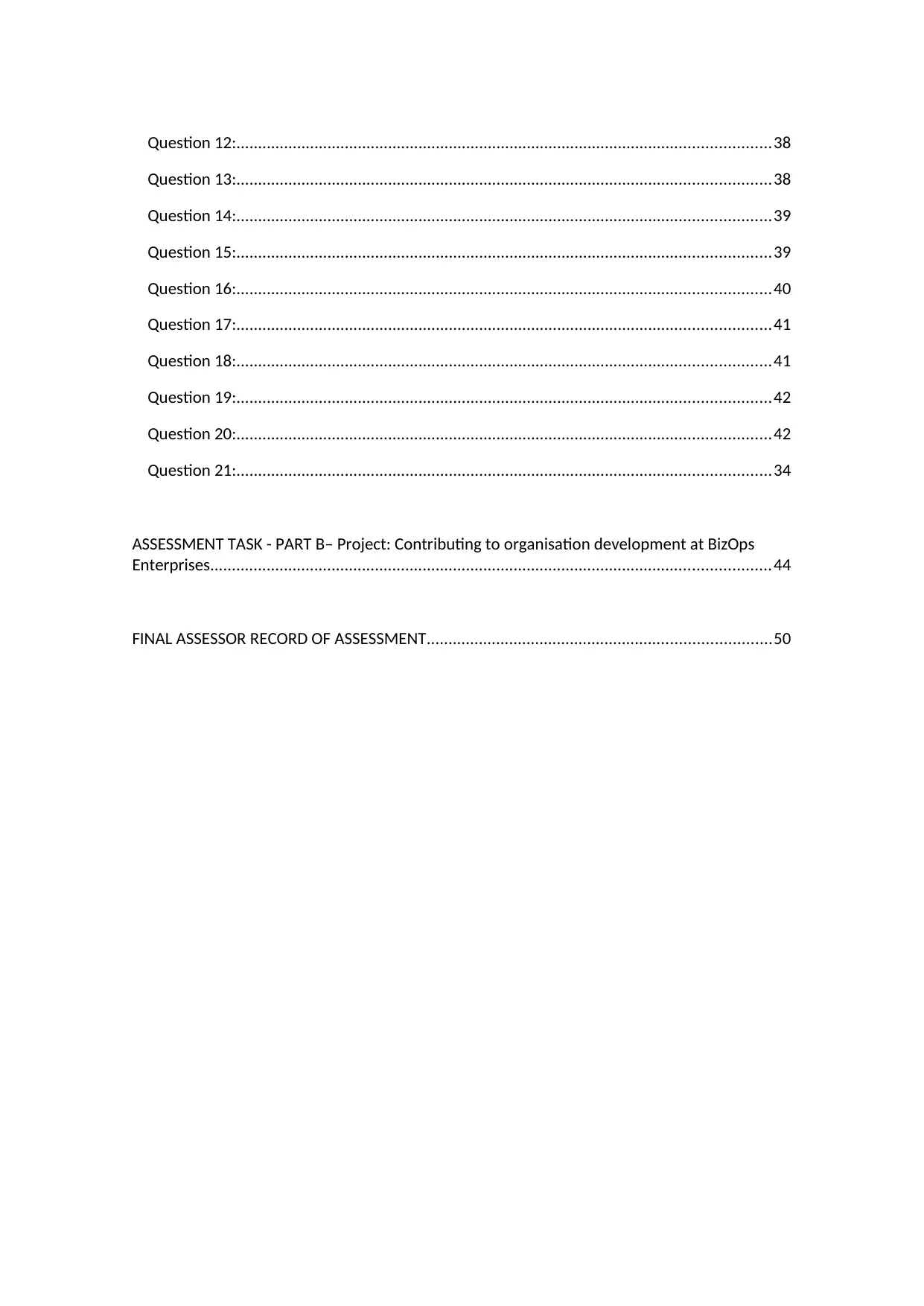
Question 12:...........................................................................................................................38
Question 13:...........................................................................................................................38
Question 14:...........................................................................................................................39
Question 15:...........................................................................................................................39
Question 16:...........................................................................................................................40
Question 17:...........................................................................................................................41
Question 18:...........................................................................................................................41
Question 19:...........................................................................................................................42
Question 20:...........................................................................................................................42
Question 21:...........................................................................................................................34
ASSESSMENT TASK - PART B– Project: Contributing to organisation development at BizOps
Enterprises.................................................................................................................................44
FINAL ASSESSOR RECORD OF ASSESSMENT...............................................................................50
Question 13:...........................................................................................................................38
Question 14:...........................................................................................................................39
Question 15:...........................................................................................................................39
Question 16:...........................................................................................................................40
Question 17:...........................................................................................................................41
Question 18:...........................................................................................................................41
Question 19:...........................................................................................................................42
Question 20:...........................................................................................................................42
Question 21:...........................................................................................................................34
ASSESSMENT TASK - PART B– Project: Contributing to organisation development at BizOps
Enterprises.................................................................................................................................44
FINAL ASSESSOR RECORD OF ASSESSMENT...............................................................................50
Paraphrase This Document
Need a fresh take? Get an instant paraphrase of this document with our AI Paraphraser
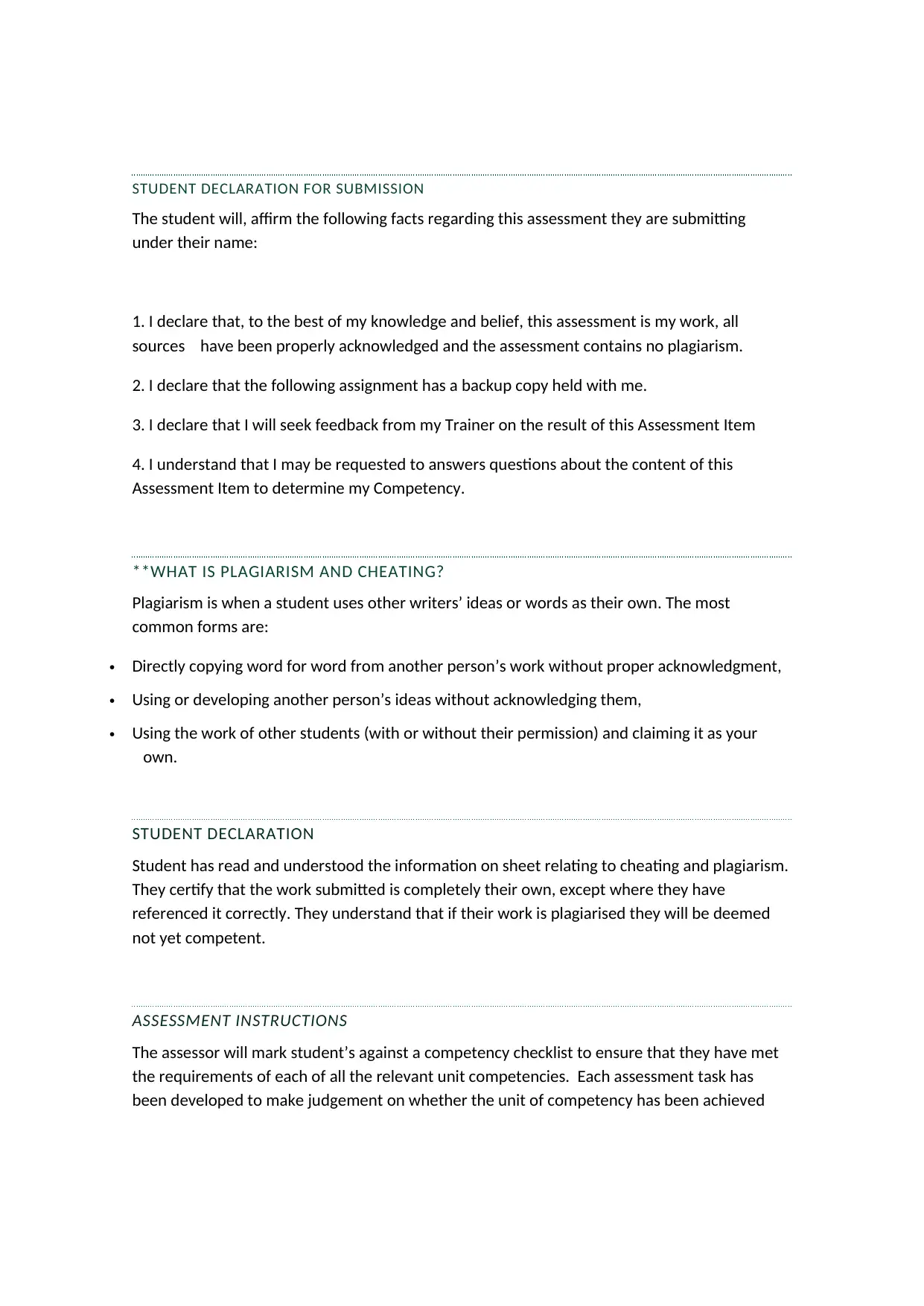
STUDENT DECLARATION FOR SUBMISSION
The student will, affirm the following facts regarding this assessment they are submitting
under their name:
1. I declare that, to the best of my knowledge and belief, this assessment is my work, all
sources have been properly acknowledged and the assessment contains no plagiarism.
2. I declare that the following assignment has a backup copy held with me.
3. I declare that I will seek feedback from my Trainer on the result of this Assessment Item
4. I understand that I may be requested to answers questions about the content of this
Assessment Item to determine my Competency.
**WHAT IS PLAGIARISM AND CHEATING?
Plagiarism is when a student uses other writers’ ideas or words as their own. The most
common forms are:
Directly copying word for word from another person’s work without proper acknowledgment,
Using or developing another person’s ideas without acknowledging them,
Using the work of other students (with or without their permission) and claiming it as your
own.
STUDENT DECLARATION
Student has read and understood the information on sheet relating to cheating and plagiarism.
They certify that the work submitted is completely their own, except where they have
referenced it correctly. They understand that if their work is plagiarised they will be deemed
not yet competent.
ASSESSMENT INSTRUCTIONS
The assessor will mark student’s against a competency checklist to ensure that they have met
the requirements of each of all the relevant unit competencies. Each assessment task has
been developed to make judgement on whether the unit of competency has been achieved
The student will, affirm the following facts regarding this assessment they are submitting
under their name:
1. I declare that, to the best of my knowledge and belief, this assessment is my work, all
sources have been properly acknowledged and the assessment contains no plagiarism.
2. I declare that the following assignment has a backup copy held with me.
3. I declare that I will seek feedback from my Trainer on the result of this Assessment Item
4. I understand that I may be requested to answers questions about the content of this
Assessment Item to determine my Competency.
**WHAT IS PLAGIARISM AND CHEATING?
Plagiarism is when a student uses other writers’ ideas or words as their own. The most
common forms are:
Directly copying word for word from another person’s work without proper acknowledgment,
Using or developing another person’s ideas without acknowledging them,
Using the work of other students (with or without their permission) and claiming it as your
own.
STUDENT DECLARATION
Student has read and understood the information on sheet relating to cheating and plagiarism.
They certify that the work submitted is completely their own, except where they have
referenced it correctly. They understand that if their work is plagiarised they will be deemed
not yet competent.
ASSESSMENT INSTRUCTIONS
The assessor will mark student’s against a competency checklist to ensure that they have met
the requirements of each of all the relevant unit competencies. Each assessment task has
been developed to make judgement on whether the unit of competency has been achieved
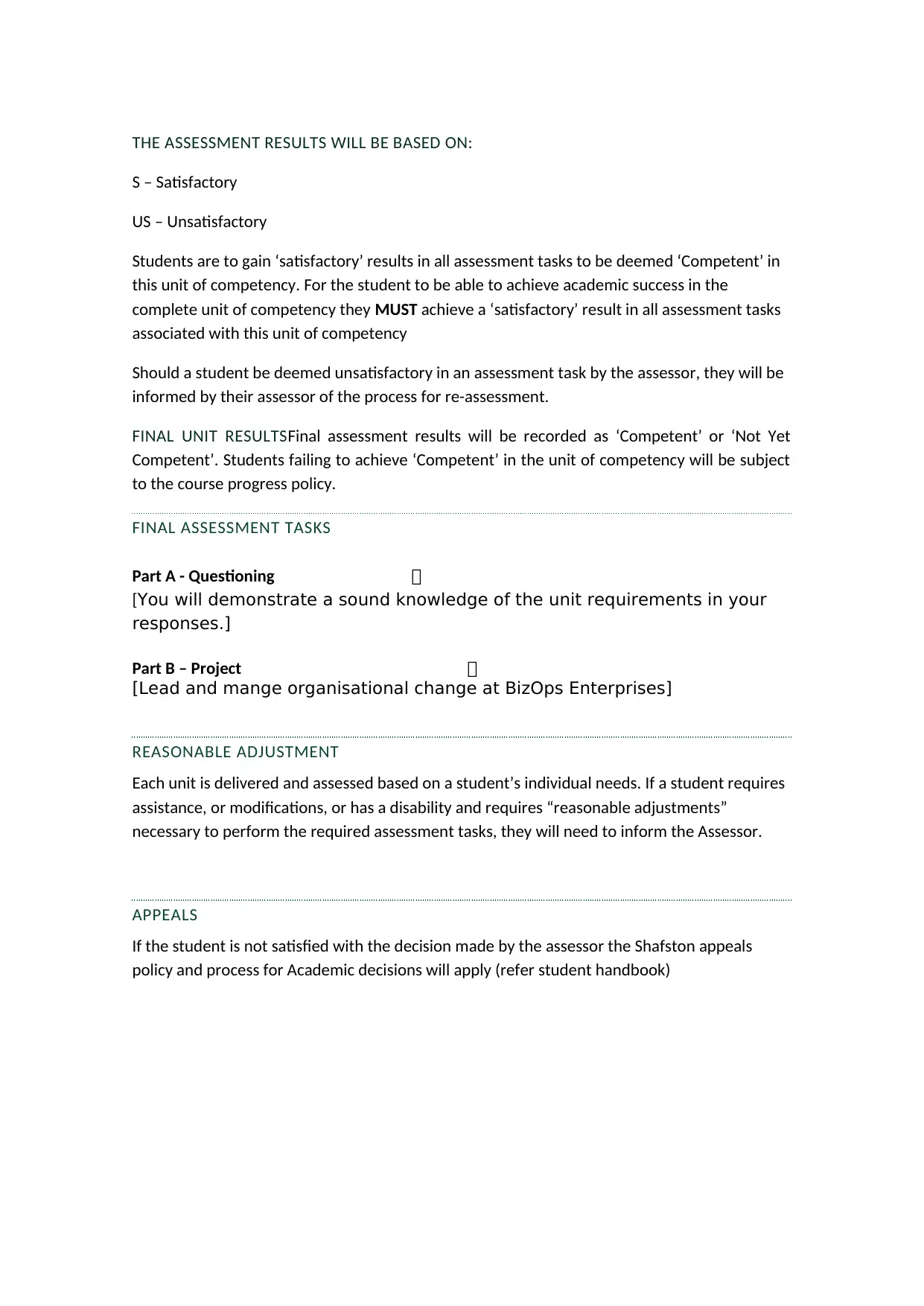
THE ASSESSMENT RESULTS WILL BE BASED ON:
S – Satisfactory
US – Unsatisfactory
Students are to gain ‘satisfactory’ results in all assessment tasks to be deemed ‘Competent’ in
this unit of competency. For the student to be able to achieve academic success in the
complete unit of competency they MUST achieve a ‘satisfactory’ result in all assessment tasks
associated with this unit of competency
Should a student be deemed unsatisfactory in an assessment task by the assessor, they will be
informed by their assessor of the process for re-assessment.
FINAL UNIT RESULTSFinal assessment results will be recorded as ‘Competent’ or ‘Not Yet
Competent’. Students failing to achieve ‘Competent’ in the unit of competency will be subject
to the course progress policy.
FINAL ASSESSMENT TASKS
Part A - Questioning
[You will demonstrate a sound knowledge of the unit requirements in your
responses.]
Part B – Project
[Lead and mange organisational change at BizOps Enterprises]
REASONABLE ADJUSTMENT
Each unit is delivered and assessed based on a student’s individual needs. If a student requires
assistance, or modifications, or has a disability and requires “reasonable adjustments”
necessary to perform the required assessment tasks, they will need to inform the Assessor.
APPEALS
If the student is not satisfied with the decision made by the assessor the Shafston appeals
policy and process for Academic decisions will apply (refer student handbook)
S – Satisfactory
US – Unsatisfactory
Students are to gain ‘satisfactory’ results in all assessment tasks to be deemed ‘Competent’ in
this unit of competency. For the student to be able to achieve academic success in the
complete unit of competency they MUST achieve a ‘satisfactory’ result in all assessment tasks
associated with this unit of competency
Should a student be deemed unsatisfactory in an assessment task by the assessor, they will be
informed by their assessor of the process for re-assessment.
FINAL UNIT RESULTSFinal assessment results will be recorded as ‘Competent’ or ‘Not Yet
Competent’. Students failing to achieve ‘Competent’ in the unit of competency will be subject
to the course progress policy.
FINAL ASSESSMENT TASKS
Part A - Questioning
[You will demonstrate a sound knowledge of the unit requirements in your
responses.]
Part B – Project
[Lead and mange organisational change at BizOps Enterprises]
REASONABLE ADJUSTMENT
Each unit is delivered and assessed based on a student’s individual needs. If a student requires
assistance, or modifications, or has a disability and requires “reasonable adjustments”
necessary to perform the required assessment tasks, they will need to inform the Assessor.
APPEALS
If the student is not satisfied with the decision made by the assessor the Shafston appeals
policy and process for Academic decisions will apply (refer student handbook)
⊘ This is a preview!⊘
Do you want full access?
Subscribe today to unlock all pages.

Trusted by 1+ million students worldwide
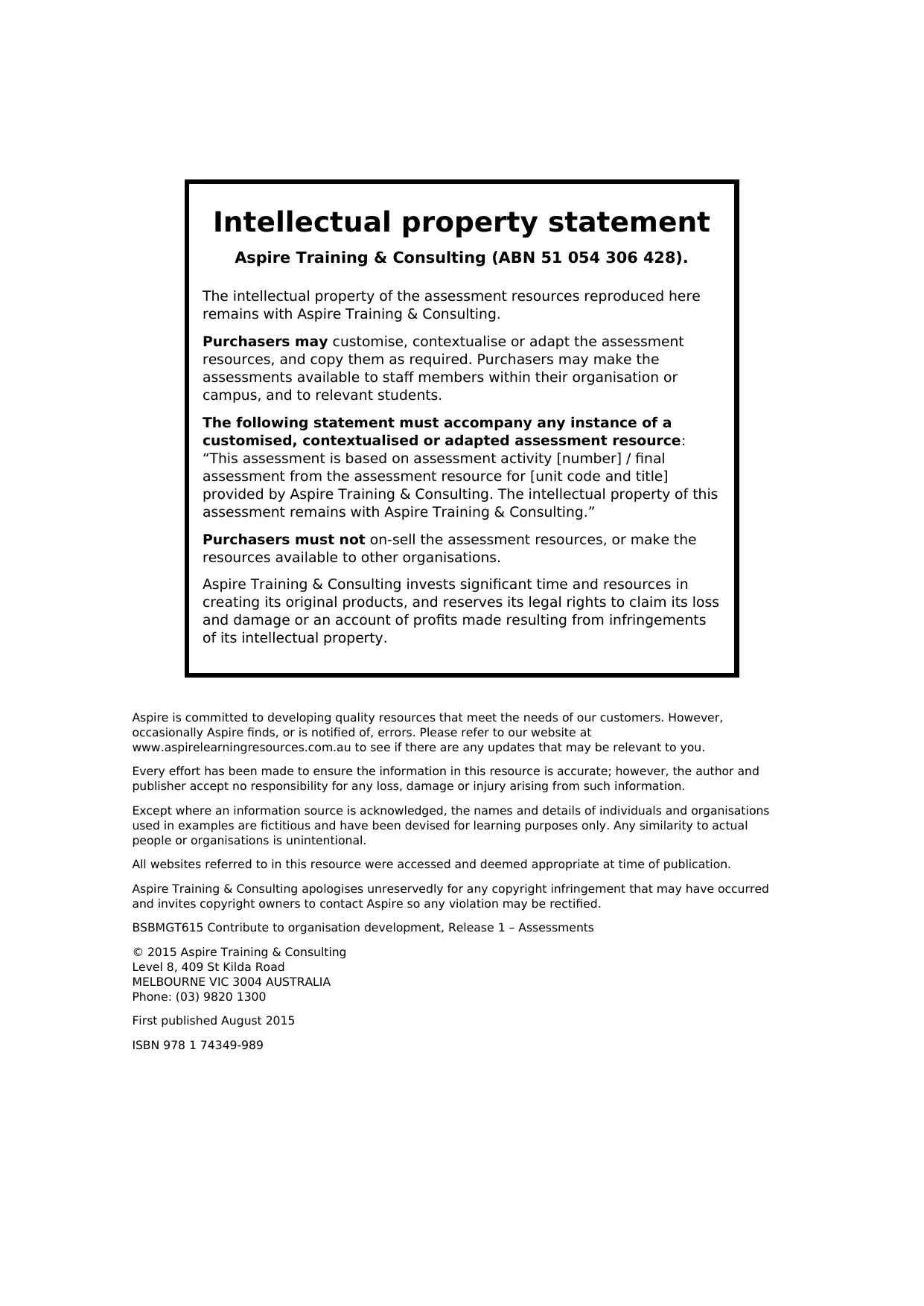
Intellectual property statement
Aspire Training & Consulting (ABN 51 054 306 428).
The intellectual property of the assessment resources reproduced here
remains with Aspire Training & Consulting.
Purchasers may customise, contextualise or adapt the assessment
resources, and copy them as required. Purchasers may make the
assessments available to staff members within their organisation or
campus, and to relevant students.
The following statement must accompany any instance of a
customised, contextualised or adapted assessment resource:
“This assessment is based on assessment activity [number] / final
assessment from the assessment resource for [unit code and title]
provided by Aspire Training & Consulting. The intellectual property of this
assessment remains with Aspire Training & Consulting.”
Purchasers must not on-sell the assessment resources, or make the
resources available to other organisations.
Aspire Training & Consulting invests significant time and resources in
creating its original products, and reserves its legal rights to claim its loss
and damage or an account of profits made resulting from infringements
of its intellectual property.
Aspire is committed to developing quality resources that meet the needs of our customers. However,
occasionally Aspire finds, or is notified of, errors. Please refer to our website at
www.aspirelearningresources.com.au to see if there are any updates that may be relevant to you.
Every effort has been made to ensure the information in this resource is accurate; however, the author and
publisher accept no responsibility for any loss, damage or injury arising from such information.
Except where an information source is acknowledged, the names and details of individuals and organisations
used in examples are fictitious and have been devised for learning purposes only. Any similarity to actual
people or organisations is unintentional.
All websites referred to in this resource were accessed and deemed appropriate at time of publication.
Aspire Training & Consulting apologises unreservedly for any copyright infringement that may have occurred
and invites copyright owners to contact Aspire so any violation may be rectified.
BSBMGT615 Contribute to organisation development, Release 1 – Assessments
© 2015 Aspire Training & Consulting
Level 8, 409 St Kilda Road
MELBOURNE VIC 3004 AUSTRALIA
Phone: (03) 9820 1300
First published August 2015
ISBN 978 1 74349-989
Aspire Training & Consulting (ABN 51 054 306 428).
The intellectual property of the assessment resources reproduced here
remains with Aspire Training & Consulting.
Purchasers may customise, contextualise or adapt the assessment
resources, and copy them as required. Purchasers may make the
assessments available to staff members within their organisation or
campus, and to relevant students.
The following statement must accompany any instance of a
customised, contextualised or adapted assessment resource:
“This assessment is based on assessment activity [number] / final
assessment from the assessment resource for [unit code and title]
provided by Aspire Training & Consulting. The intellectual property of this
assessment remains with Aspire Training & Consulting.”
Purchasers must not on-sell the assessment resources, or make the
resources available to other organisations.
Aspire Training & Consulting invests significant time and resources in
creating its original products, and reserves its legal rights to claim its loss
and damage or an account of profits made resulting from infringements
of its intellectual property.
Aspire is committed to developing quality resources that meet the needs of our customers. However,
occasionally Aspire finds, or is notified of, errors. Please refer to our website at
www.aspirelearningresources.com.au to see if there are any updates that may be relevant to you.
Every effort has been made to ensure the information in this resource is accurate; however, the author and
publisher accept no responsibility for any loss, damage or injury arising from such information.
Except where an information source is acknowledged, the names and details of individuals and organisations
used in examples are fictitious and have been devised for learning purposes only. Any similarity to actual
people or organisations is unintentional.
All websites referred to in this resource were accessed and deemed appropriate at time of publication.
Aspire Training & Consulting apologises unreservedly for any copyright infringement that may have occurred
and invites copyright owners to contact Aspire so any violation may be rectified.
BSBMGT615 Contribute to organisation development, Release 1 – Assessments
© 2015 Aspire Training & Consulting
Level 8, 409 St Kilda Road
MELBOURNE VIC 3004 AUSTRALIA
Phone: (03) 9820 1300
First published August 2015
ISBN 978 1 74349-989
Paraphrase This Document
Need a fresh take? Get an instant paraphrase of this document with our AI Paraphraser
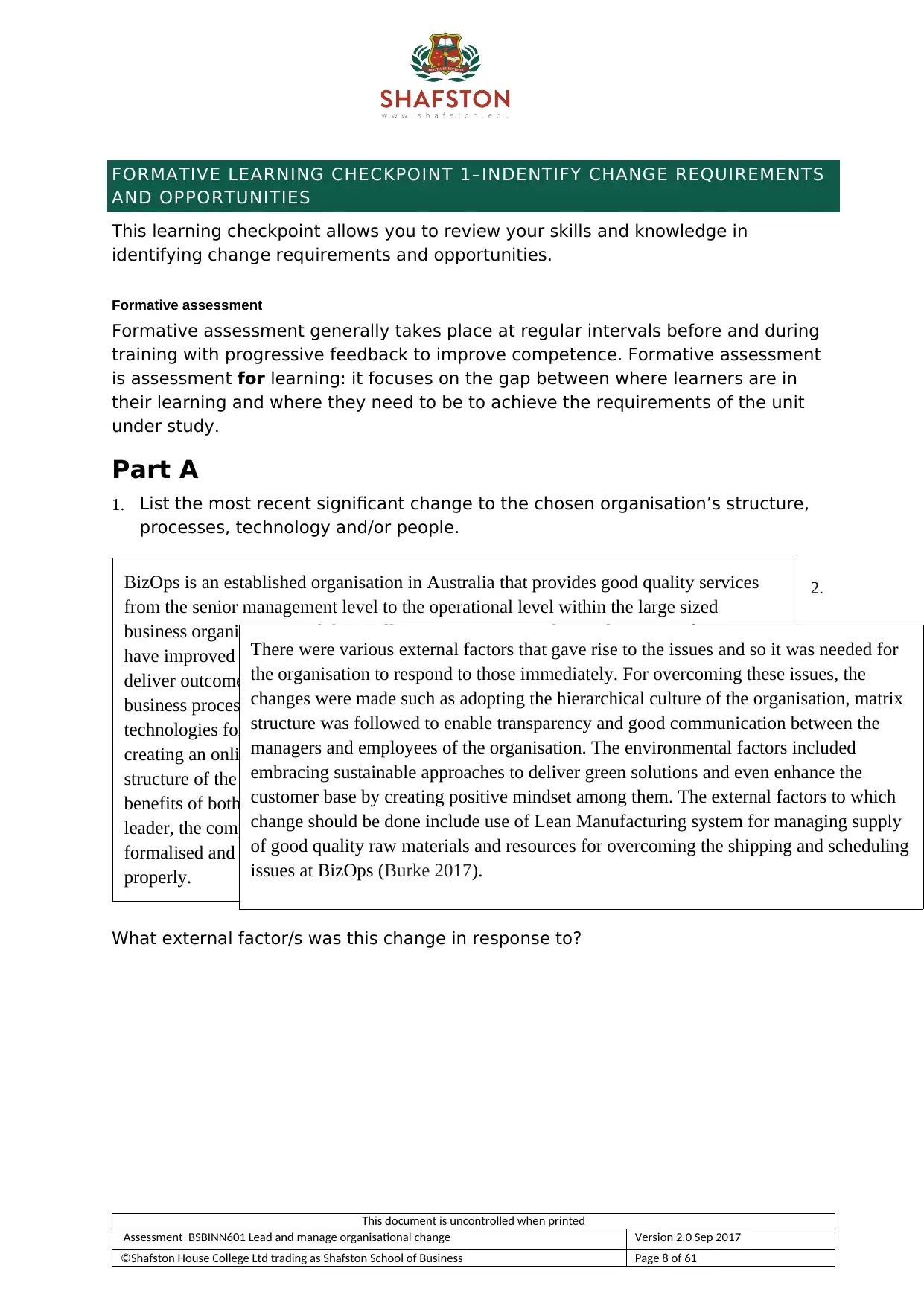
FORMATIVE LEARNING CHECKPOINT 1–INDENTIFY CHANGE REQUIREMENTS
AND OPPORTUNITIES
This learning checkpoint allows you to review your skills and knowledge in
identifying change requirements and opportunities.
Formative assessment
Formative assessment generally takes place at regular intervals before and during
training with progressive feedback to improve competence. Formative assessment
is assessment for learning: it focuses on the gap between where learners are in
their learning and where they need to be to achieve the requirements of the unit
under study.
Part A
1. List the most recent significant change to the chosen organisation’s structure,
processes, technology and/or people.
2.
What external factor/s was this change in response to?
This document is uncontrolled when printed
Assessment BSBINN601 Lead and manage organisational change Version 2.0 Sep 2017
©Shafston House College Ltd trading as Shafston School of Business Page 8 of 61
BizOps is an established organisation in Australia that provides good quality services
from the senior management level to the operational level within the large sized
business organisations and the small organisations too. The employees’ performances
have improved with the changes in organisational structure; furthermore leading to
deliver outcomes based support and enhancing the organisational efficiency. The
business processes are changed with the help of implementing new and advanced
technologies for marketing the products and services properly. It has also allowed
creating an online business and adopting sustainable approaches (Anderson 2016). The
structure of the organisation is changed from functional to matrix structure to gain the
benefits of both functional and divisional structures. Because of the lack of an effective
leader, the company has changed its culture to hierarchical culture to maintain a
formalised and structured work environment and make the organisation function
properly.
There were various external factors that gave rise to the issues and so it was needed for
the organisation to respond to those immediately. For overcoming these issues, the
changes were made such as adopting the hierarchical culture of the organisation, matrix
structure was followed to enable transparency and good communication between the
managers and employees of the organisation. The environmental factors included
embracing sustainable approaches to deliver green solutions and even enhance the
customer base by creating positive mindset among them. The external factors to which
change should be done include use of Lean Manufacturing system for managing supply
of good quality raw materials and resources for overcoming the shipping and scheduling
issues at BizOps (Burke 2017).
AND OPPORTUNITIES
This learning checkpoint allows you to review your skills and knowledge in
identifying change requirements and opportunities.
Formative assessment
Formative assessment generally takes place at regular intervals before and during
training with progressive feedback to improve competence. Formative assessment
is assessment for learning: it focuses on the gap between where learners are in
their learning and where they need to be to achieve the requirements of the unit
under study.
Part A
1. List the most recent significant change to the chosen organisation’s structure,
processes, technology and/or people.
2.
What external factor/s was this change in response to?
This document is uncontrolled when printed
Assessment BSBINN601 Lead and manage organisational change Version 2.0 Sep 2017
©Shafston House College Ltd trading as Shafston School of Business Page 8 of 61
BizOps is an established organisation in Australia that provides good quality services
from the senior management level to the operational level within the large sized
business organisations and the small organisations too. The employees’ performances
have improved with the changes in organisational structure; furthermore leading to
deliver outcomes based support and enhancing the organisational efficiency. The
business processes are changed with the help of implementing new and advanced
technologies for marketing the products and services properly. It has also allowed
creating an online business and adopting sustainable approaches (Anderson 2016). The
structure of the organisation is changed from functional to matrix structure to gain the
benefits of both functional and divisional structures. Because of the lack of an effective
leader, the company has changed its culture to hierarchical culture to maintain a
formalised and structured work environment and make the organisation function
properly.
There were various external factors that gave rise to the issues and so it was needed for
the organisation to respond to those immediately. For overcoming these issues, the
changes were made such as adopting the hierarchical culture of the organisation, matrix
structure was followed to enable transparency and good communication between the
managers and employees of the organisation. The environmental factors included
embracing sustainable approaches to deliver green solutions and even enhance the
customer base by creating positive mindset among them. The external factors to which
change should be done include use of Lean Manufacturing system for managing supply
of good quality raw materials and resources for overcoming the shipping and scheduling
issues at BizOps (Burke 2017).
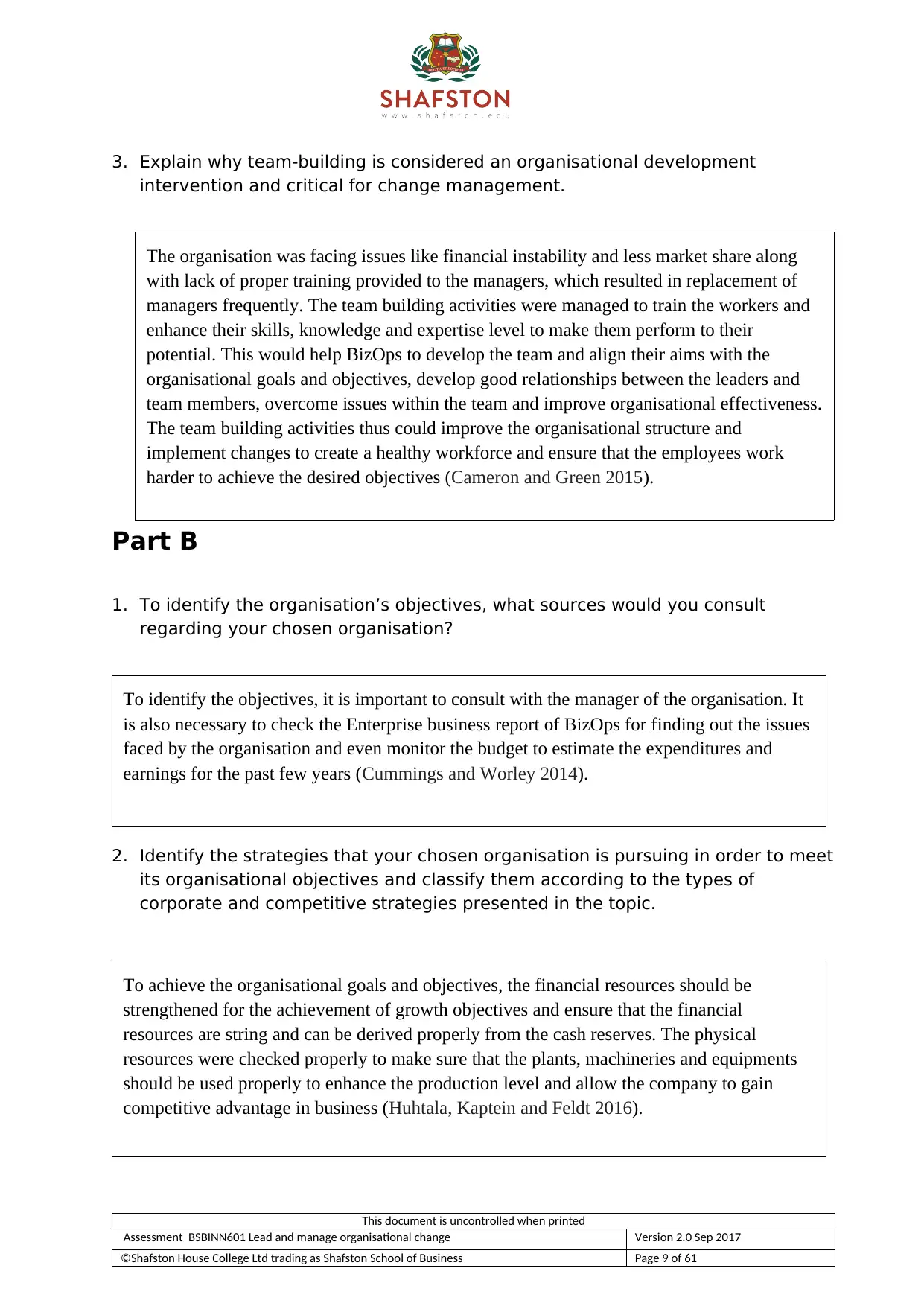
3. Explain why team-building is considered an organisational development
intervention and critical for change management.
Part B
1. To identify the organisation’s objectives, what sources would you consult
regarding your chosen organisation?
2. Identify the strategies that your chosen organisation is pursuing in order to meet
its organisational objectives and classify them according to the types of
corporate and competitive strategies presented in the topic.
This document is uncontrolled when printed
Assessment BSBINN601 Lead and manage organisational change Version 2.0 Sep 2017
©Shafston House College Ltd trading as Shafston School of Business Page 9 of 61
To identify the objectives, it is important to consult with the manager of the organisation. It
is also necessary to check the Enterprise business report of BizOps for finding out the issues
faced by the organisation and even monitor the budget to estimate the expenditures and
earnings for the past few years (Cummings and Worley 2014).
To achieve the organisational goals and objectives, the financial resources should be
strengthened for the achievement of growth objectives and ensure that the financial
resources are string and can be derived properly from the cash reserves. The physical
resources were checked properly to make sure that the plants, machineries and equipments
should be used properly to enhance the production level and allow the company to gain
competitive advantage in business (Huhtala, Kaptein and Feldt 2016).
The organisation was facing issues like financial instability and less market share along
with lack of proper training provided to the managers, which resulted in replacement of
managers frequently. The team building activities were managed to train the workers and
enhance their skills, knowledge and expertise level to make them perform to their
potential. This would help BizOps to develop the team and align their aims with the
organisational goals and objectives, develop good relationships between the leaders and
team members, overcome issues within the team and improve organisational effectiveness.
The team building activities thus could improve the organisational structure and
implement changes to create a healthy workforce and ensure that the employees work
harder to achieve the desired objectives (Cameron and Green 2015).
intervention and critical for change management.
Part B
1. To identify the organisation’s objectives, what sources would you consult
regarding your chosen organisation?
2. Identify the strategies that your chosen organisation is pursuing in order to meet
its organisational objectives and classify them according to the types of
corporate and competitive strategies presented in the topic.
This document is uncontrolled when printed
Assessment BSBINN601 Lead and manage organisational change Version 2.0 Sep 2017
©Shafston House College Ltd trading as Shafston School of Business Page 9 of 61
To identify the objectives, it is important to consult with the manager of the organisation. It
is also necessary to check the Enterprise business report of BizOps for finding out the issues
faced by the organisation and even monitor the budget to estimate the expenditures and
earnings for the past few years (Cummings and Worley 2014).
To achieve the organisational goals and objectives, the financial resources should be
strengthened for the achievement of growth objectives and ensure that the financial
resources are string and can be derived properly from the cash reserves. The physical
resources were checked properly to make sure that the plants, machineries and equipments
should be used properly to enhance the production level and allow the company to gain
competitive advantage in business (Huhtala, Kaptein and Feldt 2016).
The organisation was facing issues like financial instability and less market share along
with lack of proper training provided to the managers, which resulted in replacement of
managers frequently. The team building activities were managed to train the workers and
enhance their skills, knowledge and expertise level to make them perform to their
potential. This would help BizOps to develop the team and align their aims with the
organisational goals and objectives, develop good relationships between the leaders and
team members, overcome issues within the team and improve organisational effectiveness.
The team building activities thus could improve the organisational structure and
implement changes to create a healthy workforce and ensure that the employees work
harder to achieve the desired objectives (Cameron and Green 2015).
⊘ This is a preview!⊘
Do you want full access?
Subscribe today to unlock all pages.

Trusted by 1+ million students worldwide
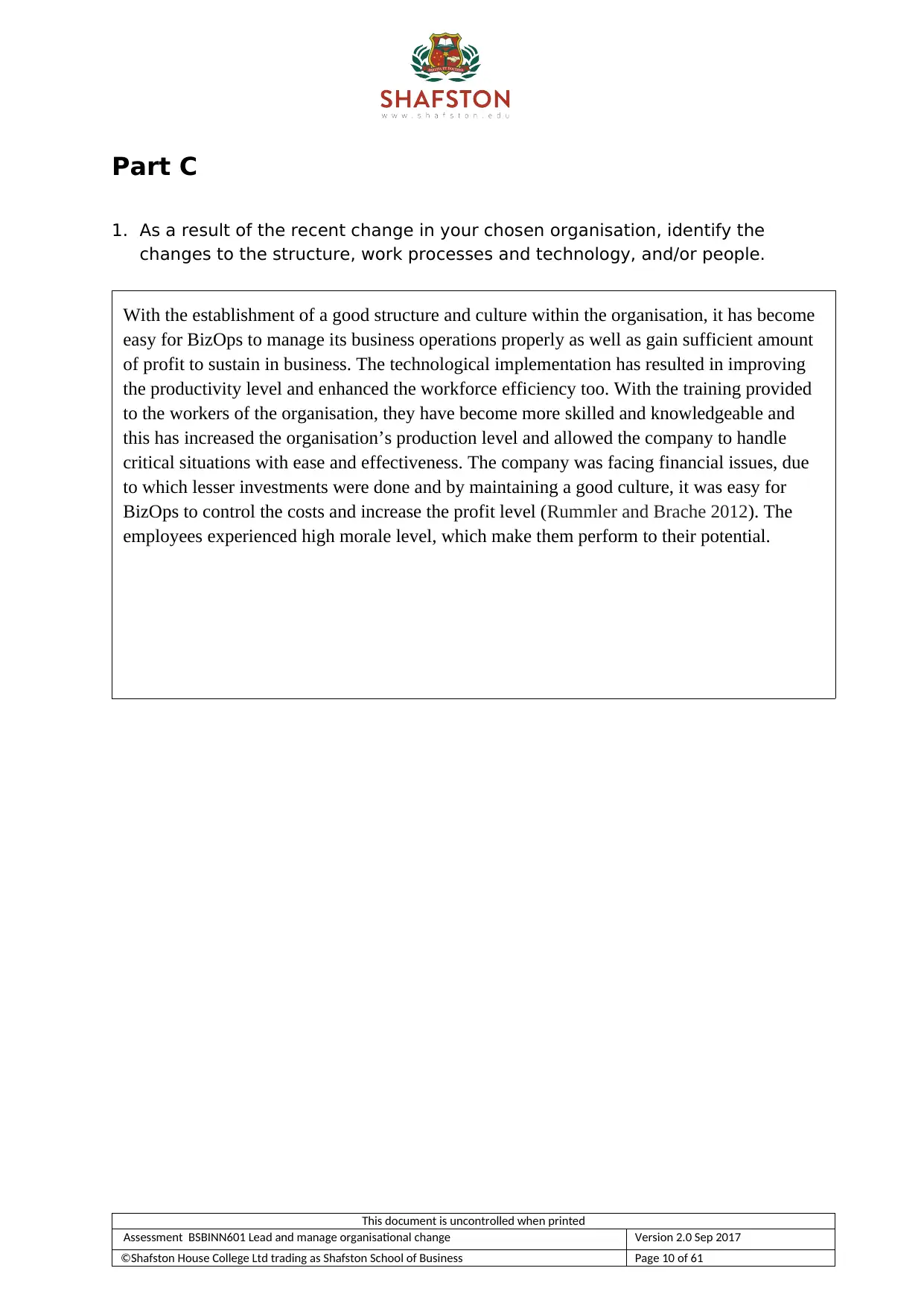
Part C
1. As a result of the recent change in your chosen organisation, identify the
changes to the structure, work processes and technology, and/or people.
This document is uncontrolled when printed
Assessment BSBINN601 Lead and manage organisational change Version 2.0 Sep 2017
©Shafston House College Ltd trading as Shafston School of Business Page 10 of 61
With the establishment of a good structure and culture within the organisation, it has become
easy for BizOps to manage its business operations properly as well as gain sufficient amount
of profit to sustain in business. The technological implementation has resulted in improving
the productivity level and enhanced the workforce efficiency too. With the training provided
to the workers of the organisation, they have become more skilled and knowledgeable and
this has increased the organisation’s production level and allowed the company to handle
critical situations with ease and effectiveness. The company was facing financial issues, due
to which lesser investments were done and by maintaining a good culture, it was easy for
BizOps to control the costs and increase the profit level (Rummler and Brache 2012). The
employees experienced high morale level, which make them perform to their potential.
1. As a result of the recent change in your chosen organisation, identify the
changes to the structure, work processes and technology, and/or people.
This document is uncontrolled when printed
Assessment BSBINN601 Lead and manage organisational change Version 2.0 Sep 2017
©Shafston House College Ltd trading as Shafston School of Business Page 10 of 61
With the establishment of a good structure and culture within the organisation, it has become
easy for BizOps to manage its business operations properly as well as gain sufficient amount
of profit to sustain in business. The technological implementation has resulted in improving
the productivity level and enhanced the workforce efficiency too. With the training provided
to the workers of the organisation, they have become more skilled and knowledgeable and
this has increased the organisation’s production level and allowed the company to handle
critical situations with ease and effectiveness. The company was facing financial issues, due
to which lesser investments were done and by maintaining a good culture, it was easy for
BizOps to control the costs and increase the profit level (Rummler and Brache 2012). The
employees experienced high morale level, which make them perform to their potential.
Paraphrase This Document
Need a fresh take? Get an instant paraphrase of this document with our AI Paraphraser
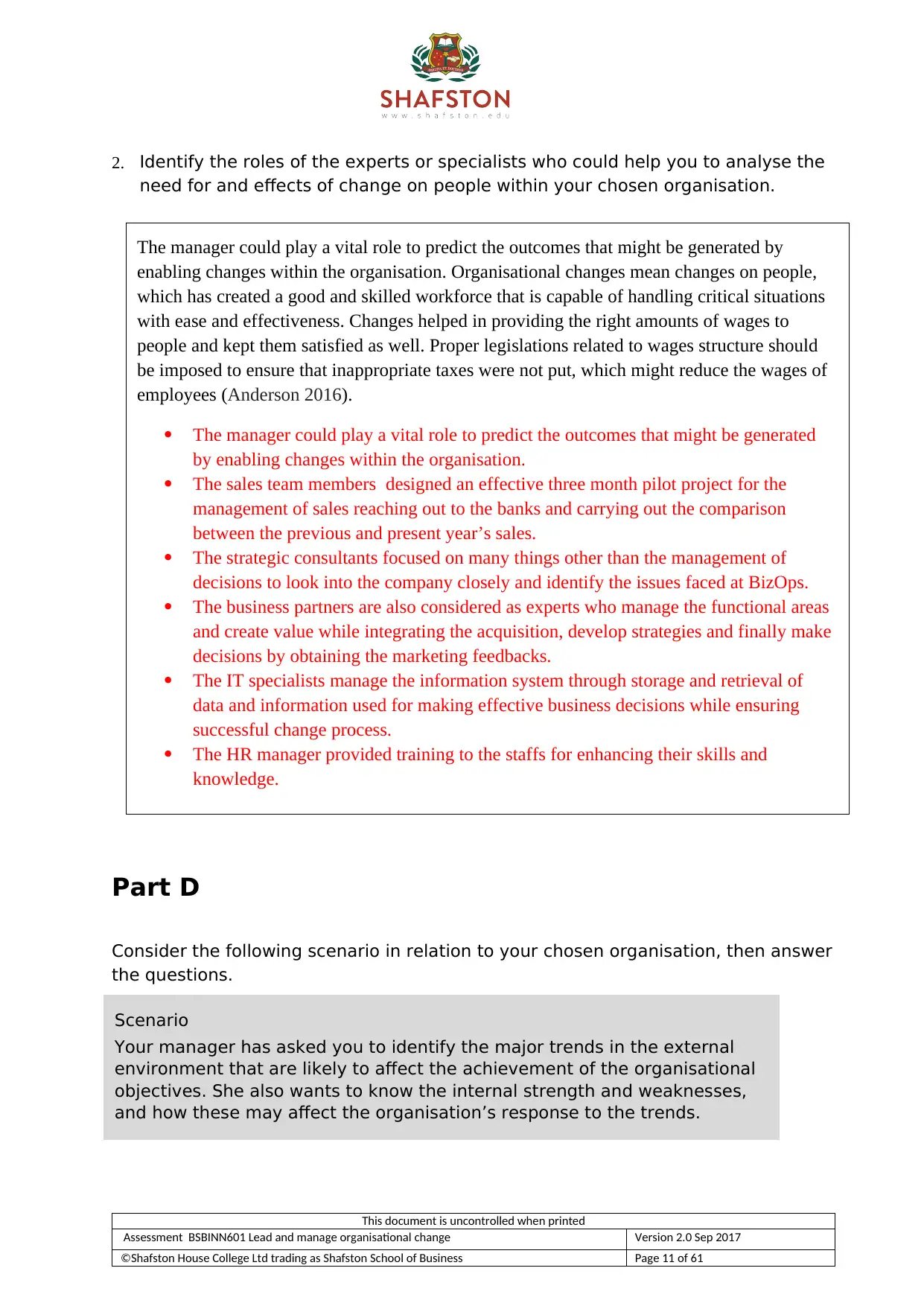
2. Identify the roles of the experts or specialists who could help you to analyse the
need for and effects of change on people within your chosen organisation.
Part D
Consider the following scenario in relation to your chosen organisation, then answer
the questions.
Scenario
Your manager has asked you to identify the major trends in the external
environment that are likely to affect the achievement of the organisational
objectives. She also wants to know the internal strength and weaknesses,
and how these may affect the organisation’s response to the trends.
This document is uncontrolled when printed
Assessment BSBINN601 Lead and manage organisational change Version 2.0 Sep 2017
©Shafston House College Ltd trading as Shafston School of Business Page 11 of 61
The manager could play a vital role to predict the outcomes that might be generated by
enabling changes within the organisation. Organisational changes mean changes on people,
which has created a good and skilled workforce that is capable of handling critical situations
with ease and effectiveness. Changes helped in providing the right amounts of wages to
people and kept them satisfied as well. Proper legislations related to wages structure should
be imposed to ensure that inappropriate taxes were not put, which might reduce the wages of
employees (Anderson 2016).
The manager could play a vital role to predict the outcomes that might be generated
by enabling changes within the organisation.
The sales team members designed an effective three month pilot project for the
management of sales reaching out to the banks and carrying out the comparison
between the previous and present year’s sales.
The strategic consultants focused on many things other than the management of
decisions to look into the company closely and identify the issues faced at BizOps.
The business partners are also considered as experts who manage the functional areas
and create value while integrating the acquisition, develop strategies and finally make
decisions by obtaining the marketing feedbacks.
The IT specialists manage the information system through storage and retrieval of
data and information used for making effective business decisions while ensuring
successful change process.
The HR manager provided training to the staffs for enhancing their skills and
knowledge.
need for and effects of change on people within your chosen organisation.
Part D
Consider the following scenario in relation to your chosen organisation, then answer
the questions.
Scenario
Your manager has asked you to identify the major trends in the external
environment that are likely to affect the achievement of the organisational
objectives. She also wants to know the internal strength and weaknesses,
and how these may affect the organisation’s response to the trends.
This document is uncontrolled when printed
Assessment BSBINN601 Lead and manage organisational change Version 2.0 Sep 2017
©Shafston House College Ltd trading as Shafston School of Business Page 11 of 61
The manager could play a vital role to predict the outcomes that might be generated by
enabling changes within the organisation. Organisational changes mean changes on people,
which has created a good and skilled workforce that is capable of handling critical situations
with ease and effectiveness. Changes helped in providing the right amounts of wages to
people and kept them satisfied as well. Proper legislations related to wages structure should
be imposed to ensure that inappropriate taxes were not put, which might reduce the wages of
employees (Anderson 2016).
The manager could play a vital role to predict the outcomes that might be generated
by enabling changes within the organisation.
The sales team members designed an effective three month pilot project for the
management of sales reaching out to the banks and carrying out the comparison
between the previous and present year’s sales.
The strategic consultants focused on many things other than the management of
decisions to look into the company closely and identify the issues faced at BizOps.
The business partners are also considered as experts who manage the functional areas
and create value while integrating the acquisition, develop strategies and finally make
decisions by obtaining the marketing feedbacks.
The IT specialists manage the information system through storage and retrieval of
data and information used for making effective business decisions while ensuring
successful change process.
The HR manager provided training to the staffs for enhancing their skills and
knowledge.
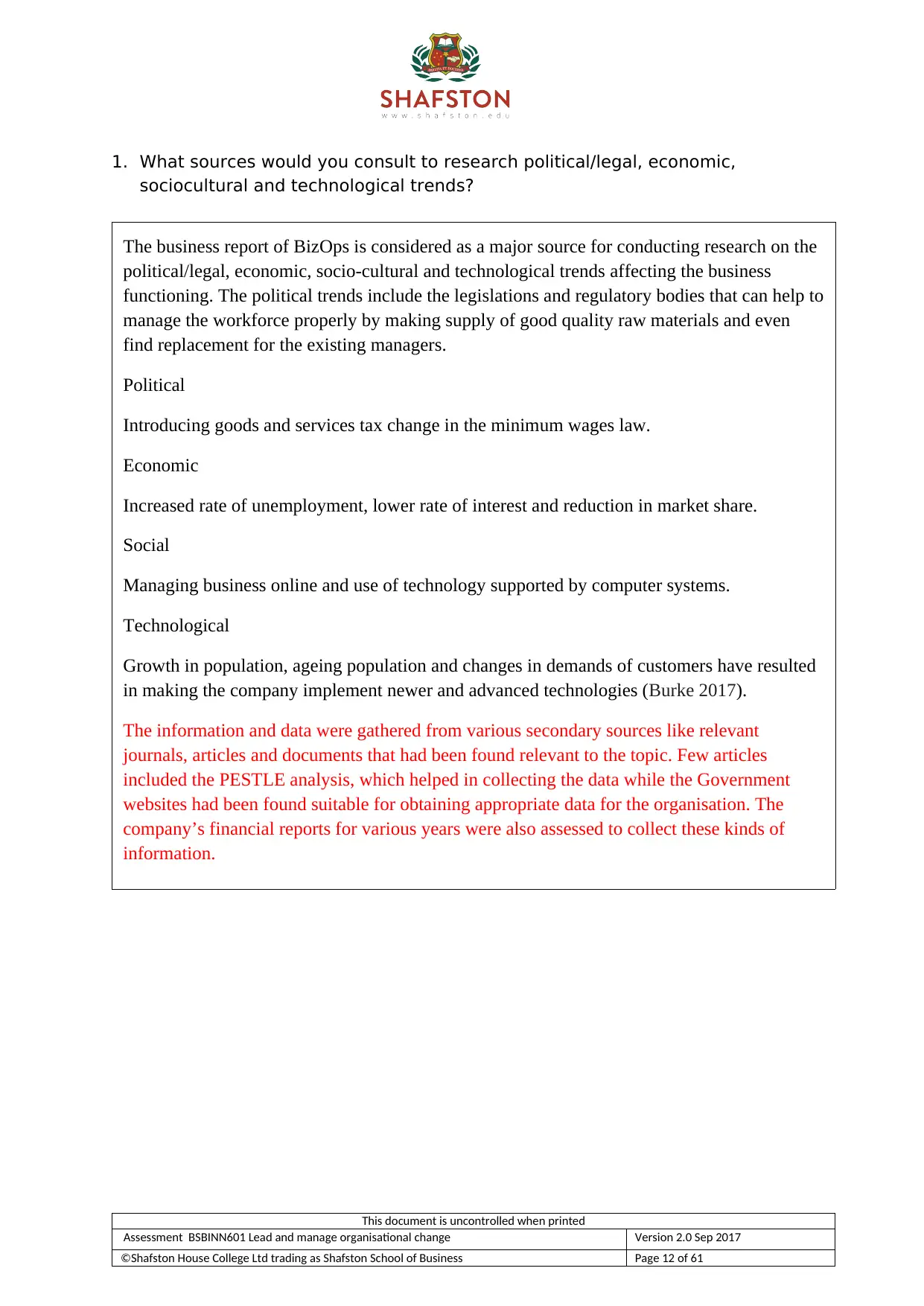
1. What sources would you consult to research political/legal, economic,
sociocultural and technological trends?
This document is uncontrolled when printed
Assessment BSBINN601 Lead and manage organisational change Version 2.0 Sep 2017
©Shafston House College Ltd trading as Shafston School of Business Page 12 of 61
The business report of BizOps is considered as a major source for conducting research on the
political/legal, economic, socio-cultural and technological trends affecting the business
functioning. The political trends include the legislations and regulatory bodies that can help to
manage the workforce properly by making supply of good quality raw materials and even
find replacement for the existing managers.
Political
Introducing goods and services tax change in the minimum wages law.
Economic
Increased rate of unemployment, lower rate of interest and reduction in market share.
Social
Managing business online and use of technology supported by computer systems.
Technological
Growth in population, ageing population and changes in demands of customers have resulted
in making the company implement newer and advanced technologies (Burke 2017).
The information and data were gathered from various secondary sources like relevant
journals, articles and documents that had been found relevant to the topic. Few articles
included the PESTLE analysis, which helped in collecting the data while the Government
websites had been found suitable for obtaining appropriate data for the organisation. The
company’s financial reports for various years were also assessed to collect these kinds of
information.
sociocultural and technological trends?
This document is uncontrolled when printed
Assessment BSBINN601 Lead and manage organisational change Version 2.0 Sep 2017
©Shafston House College Ltd trading as Shafston School of Business Page 12 of 61
The business report of BizOps is considered as a major source for conducting research on the
political/legal, economic, socio-cultural and technological trends affecting the business
functioning. The political trends include the legislations and regulatory bodies that can help to
manage the workforce properly by making supply of good quality raw materials and even
find replacement for the existing managers.
Political
Introducing goods and services tax change in the minimum wages law.
Economic
Increased rate of unemployment, lower rate of interest and reduction in market share.
Social
Managing business online and use of technology supported by computer systems.
Technological
Growth in population, ageing population and changes in demands of customers have resulted
in making the company implement newer and advanced technologies (Burke 2017).
The information and data were gathered from various secondary sources like relevant
journals, articles and documents that had been found relevant to the topic. Few articles
included the PESTLE analysis, which helped in collecting the data while the Government
websites had been found suitable for obtaining appropriate data for the organisation. The
company’s financial reports for various years were also assessed to collect these kinds of
information.
⊘ This is a preview!⊘
Do you want full access?
Subscribe today to unlock all pages.

Trusted by 1+ million students worldwide
1 out of 59
Related Documents
Your All-in-One AI-Powered Toolkit for Academic Success.
+13062052269
info@desklib.com
Available 24*7 on WhatsApp / Email
![[object Object]](/_next/static/media/star-bottom.7253800d.svg)
Unlock your academic potential
Copyright © 2020–2025 A2Z Services. All Rights Reserved. Developed and managed by ZUCOL.





